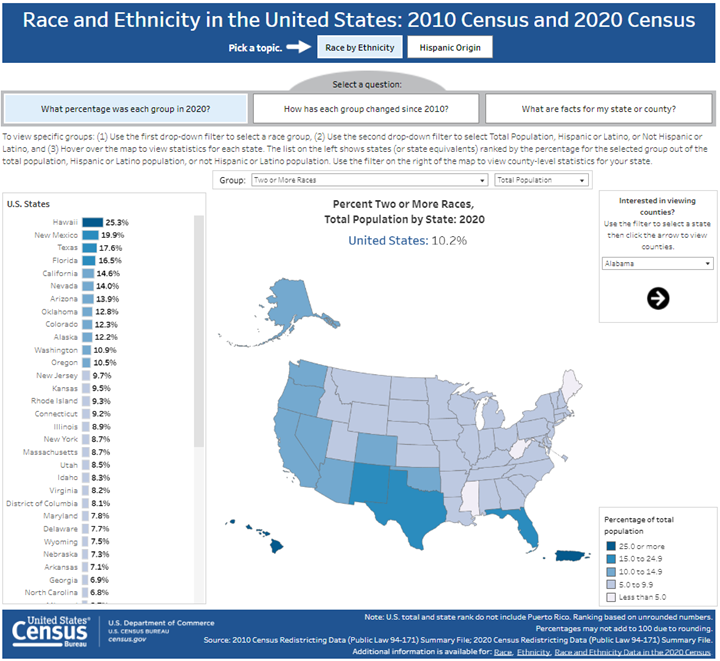
An official website of the United States government
Here’s how you know
Official websites use .gov
A .gov website belongs to an official government organization in the United States.
Secure .gov websites use HTTPS
A lock (
) or https:// means you’ve safely connected to the .gov website. Share sensitive information only on official, secure websites.
-
//
- Census.gov /
- Newsroom /
- Stats for Stories /
- Multiracial Heritage Week: June 7-14, 2023
Multiracial Heritage Week: June 7-14, 2023
Share
From Census.gov / Topics / Population / Race / About:
The data on race were derived from answers to the question on race that was asked of individuals in the United States. The Census Bureau collects racial data in accordance with guidelines provided by the U.S. Office of Management and Budget (OMB), and these data are based on self-identification.
The racial categories included in the census questionnaire generally reflect a social definition of race recognized in this country and not an attempt to define race biologically, anthropologically, or genetically. In addition, it is recognized that the categories of the race item include racial and national origin or sociocultural groups. People may choose to report more than one race to indicate their racial mixture, such as “American Indian” and “White.” People who identify their origin as Hispanic, Latino, or Spanish may be of any race.
OMB requires five minimum categories: White, Black or African American, American Indian or Alaska Native, Asian, and Native Hawaiian or Other Pacific Islander.
Key Stats
The 2020 Census shows the largest Multiracial combinations in 2020 were White and Some Other Race (19.3 million), White and American Indian and Alaska Native (4 million), White and Black or African American (3.1 million), White and Asian (2.7 million), and Black or African American and Some Other Race (1 million).
Source: 2010 and 2020 Census Redistricting Data (Public Law 94-171) Summary File.
Note: The group selected above is “Two or More Races” for the total population.
More Stats
From Topics / Population:
- Population and Housing Unit Estimates. Produces estimates of the population for the United States, its states, counties, cities, and towns, as well as for the Commonwealth of Puerto Rico.
- Population Projections. Population projections are estimates of the population for future dates.
- Ancestry. Ancestry refers to a person’s ethnic origin or descent, "roots," or heritage, or the place of birth of the person or the person’s parents or ancestors.
- Foreign Born. The foreign-born population includes anyone who is not a U.S. citizen at birth, including those who have become U.S. citizens through naturalization.
- Hispanic Origin. People who identify with the terms “Hispanic” or “Latino” are those who classify themselves in one of the specific Hispanic or Latino categories.
Source: 2019 Population Estimates.
-
Estimates of the Components of Resident Population Change by Race and Hispanic Origin for the United States: April 1, 2020 to July 1, 2021 (find Two or More Races) [< 1.0 MB]
-
Estimates of the Components of Resident Population Change by Race and Hispanic Origin for the United States: April 1, 2010 to July 1, 2019 (find Two or More Races) [< 1.0 MB]
From the Library:
-
America Counts: Stories About Race
-
America Counts: Nearly a Third Reporting Two or More Races Were Under 18 in 2020 (June 2023)
-
Missing Medicaid Data on Race/Ethnicity May Bias Health Research (April 2023)
-
More Education Does Not Erase Racial Disparities in Health Coverage (March 2023)
-
Wealth Inequality in the U.S. by Household Type (August 2022)
From the Newsroom:
-
Race News
-
Director's Blog: Valuable New Datasets on Race and Ethnicity From the U.S. Census Bureau (May 22, 2023)
-
Random Samplings Blog: Examining the Racial and Ethnic Diversity of Adults and Children (May 22, 2023)
-
Press Release: Current Population Survey Annual Social and Economical Supplement Now Available by Sex for Race, Hispanic Origin and Foreign-Born Populations (October 31, 2022)
-
Stats for Stories: Global Diversity Awareness Month: October 2022 (October 2022)
-
Random Samplings Blog: Plans for Producing Detailed Racial, Ethnic and Tribal Data from the 2020 Census (April 27, 2022)
-
Census Interactive Gallery: Measurement of Race and Ethnicity Across the Decades: 1790–2020 (August 2021)
From Topics / Research:
Outside Links
Some content on this site is available in several different electronic formats. Some of the files may require a plug-in or additional software to view.
The content on this page includes a link to a non-government website. Our linking to these sites does not constitute an endorsement of any products, services or the information found on them. Once you link to another site you are subject to the policies of the new site.
 Yes
Yes
 No
NoComments or suggestions?


Top





